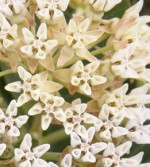 This herbaceous perennial,also known as purple silkweed, is a native of Rocky Mountain West from Wyoming to southern Arizona, west to Nevada where it grows in prairies and along roadsides. It is a member of the dogbane family, Apocynaceae, that also includes bluestar (Amsonia), periwinkle (Vinca), and oleander (Nerium). The plants are usually unbranched and carry lanceolate to narrowly ovate gray-green leaves that may be softly hairy and up to five inches long and two inches wide. The flowers are produced in terminal or lateral umbels 1.5 to 2.5 inches across in summer and have dull purple to pink petals and yellowish white hoods. The seed capsules are 3 to 4.7 inches long. Although native to the US plants are more popular in English gardens. The generic name Ascllepias is the name of the Greek doctor of medicine.
This herbaceous perennial,also known as purple silkweed, is a native of Rocky Mountain West from Wyoming to southern Arizona, west to Nevada where it grows in prairies and along roadsides. It is a member of the dogbane family, Apocynaceae, that also includes bluestar (Amsonia), periwinkle (Vinca), and oleander (Nerium). The plants are usually unbranched and carry lanceolate to narrowly ovate gray-green leaves that may be softly hairy and up to five inches long and two inches wide. The flowers are produced in terminal or lateral umbels 1.5 to 2.5 inches across in summer and have dull purple to pink petals and yellowish white hoods. The seed capsules are 3 to 4.7 inches long. Although native to the US plants are more popular in English gardens. The generic name Ascllepias is the name of the Greek doctor of medicine.
Type: Herbaceous perennial
Bloom: Terminal or lateral umbels of flowers with pink to purple petals and yellowish white hoods in summer
Size: 1-1.5’ H 1’ W
Light: Full sun
Soil: Average, dry to moist, well-drained
Hardiness: Zones 4-8
Care: Low maintenance
Pests and Diseases: Aphids, root rot
Propagation: Seed, stem cuttings in early spring or fall
Companion Plants: Blanket flower, aspen daisy, blue mist penstemon, artemesias, pearly everlasting